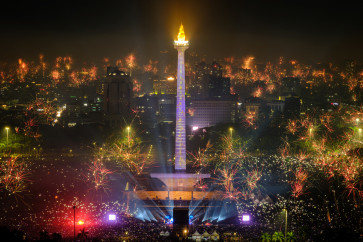Popular Reads
Top Results
Can't find what you're looking for?
View all search resultsPopular Reads
Top Results
Can't find what you're looking for?
View all search resultsChina’s nine-dash line revisited
China might feel compelled to revert to a historic approach when it comes to asserting its right to fish in the so-called “traditional fishing grounds” outlined according to China’s nine-dash line
Change text size
Gift Premium Articles
to Anyone

C
hina might feel compelled to revert to a historic approach when it comes to asserting its right to fish in the so-called “traditional fishing grounds” outlined according to China’s nine-dash line. This is because China is likely to lose to the Philippines in a case brought by the latter before the Permanent Court of Arbitration in The Hague. The Permanent Court of Arbitration is scheduled to issue a decision on the dispute by July 12.
Among the questions the Philippines has asked the arbiters to address is the validity, if not the legality, of China’s nine-dash line. One of the questions is, in effect, whether or not China’s nine-dash line, which is not measured from a land base line as required by the United Nations Convention on the Law of the Sea (UNCLOS), to which China is a party, can encroach on the exclusive economic zone (EEZ) of other coastal states bordering the South China Sea.
Due to such encroachment, several ASEAN countries are currently embroiled in maritime disputes with China. In Vietnam, the disputed zone covers 50 percent of Vietnam’s entire EEZ. Thirty percent of Indonesia’s Natuna Islands, a potentially disputed zone, falls within China’s nine-dash line and 80 percent of Malaysia’s Sabah and Sarawak EEZ is disputed. Eighty percent of the Philippines’ West Sea EEZ is also disputed.
As these matters concern EEZ, the decision of the Permanent Court of Arbitration is expected to confirm that China’s nine-dash line is contrary to the interpretation and application of UNCLOS. The decision will strengthen law enforcement measures taken against illegal undocumented and unregulated (IUU) fishing in Indonesia’s EEZ.
If it loses the case, China might exploit history as a tool to justify its “traditional fishing grounds”. The people of China are very proud of their long history and of the advancement of their civilization. History can be exploited to encourage nationalism, which in turn can be used to engineer support for China’s maritime diplomacy such as the development of fishermen-militias, reclamation, military build-up and so forth.
But China’s historical approach has limitations, which in turn are prejudicial to China’s historical claims.
First is the matter of distance. UNCLOS limits the application of historic title to cases relating to the delimitation of territorial sea (see Article 15). Historic title does not apply to delimitation of EEZ, continental shelf, or the high seas.
China has openly declared James Shoal as the southern most point of the South China Sea (SCS) in which China has a historic right. While James Shoal is only 43 nautical miles from Bintulu, Sarawak, it is 1,100 nm from mainland China. UNCLOS is unlikely to allow China to exercise historic rights beyond its territorial sea, 12 nm.
The Gulf of Mine case, which was settled at the International Court of Justice (ICJ), coined a legal principle in which EEZ overrides any prior usage rights claimed by other states in the area. This means that the establishment of Indonesia’s EEZ in Natuna overrides China’s “traditional fishing ground” claim.
Secondly, China’s historical claims are inconsistent. If one were to observe a collection of Chinese maps from 1935 through to 2009, he or she would be confused by the numerous versions of the dash line, which has, at times been cited as an 11-dash line, a 10-dash line, or nine. There are no coordinates to locate the dash line, which has always shifted. For instance, the nearest dash line to the Natuna segment has, at times, been located to the north of the islands and sometimes to the northeast.
Third, China’s historical claim over the SCS has never been supported by a continuous and effective exercise of authority. China’s claim has consistently been challenged or faced counter-claim by neighboring states.
And lastly, as the matter concerns ancient history, Indonesia’s claim is also backed by strong historical evidence. If China plans to refer to its Yuan and Qing dynasties to make an argument to claim its alleged historic rights over the SCS, including Natuna waters, Indonesia could also refer to its own Srivijaya and Majapahit empires for the same purpose.
In the heyday of the Srivijaya empire in 8th century, expansion extended into the Greater Mekong sub-region, the Srivijaya navy dominated the southern part of the SCS and the Gulf of Thailand. For almost two centuries, Srivijaya expanded its territory to the north to Lavo in the Gulf of Thailand, Indrapura in Cambodia and the Mean Valley, Sou Yai, Nha Trang and Phan Rang on the south-eastern coast of modern-day Vietnam. There is no historical record that the Chinese ever challenged Srivijaya’s expansion in the SCS.
Majapahit replaced Srivijaya. During the golden years of the Majapahit from the 13th to 14th centuries, as discussed in the book Nagarakretagama, Majapahit territory expanded to include more than 85 vassals and islands. In Robert Cribb’s The Historical Atlas of Indonesia, an almost straight line was drawn from Kelantan of Hujung Medini (Malay Peninsula) to Malano/Berune of Tanjung Pura (Sabah in modern-day Borneo). The line, which made up the southern part of the SCS, where the Natuna Islands are located, was under the control of the Majapahit navy. There are also no historical records that suggest that Majapahit territory was ever challenged by the Chinese.
While history is an important element required to understand the background of a legal case, the prevention and the settlement of disputes in the SCS should be guided by the spirit of amity and cooperation that politically bind ASEAN and China together, as well as the principle of modern international laws such as UNCLOS. The nine-dash line may remain in Chinese maps, but perhaps with a new interpretation favorable to all.
_____________
The author is director general/head of the Policy Analysis and Development Agency, Ministry of Foreign Affairs. The views expressed are his own.









